Related Research Articles

Ethnobotany is the study of a region's plants and their practical uses through the traditional knowledge of a local culture and people. An ethnobotanist thus strives to document the local customs involving the practical uses of local flora for many aspects of life, such as plants as medicines, foods, intoxicants and clothing. Richard Evans Schultes, often referred to as the "father of ethnobotany", explained the discipline in this way:
Ethnobotany simply means ... investigating plants used by societies in various parts of the world.
The O'odham peoples, including the Tohono O'odham, the Pima or Akimel O'odham, and the Hia C-ed O'odham, are indigenous Uto-Aztecan peoples of the Sonoran desert in southern and central Arizona and northern Sonora, united by a common heritage language, the O'odham language. Today, many O'odham live in the Tohono O'odham Nation, the San Xavier Indian Reservation, the Gila River Indian Community, the Salt River Pima-Maricopa Indian Community, the Ak-Chin Indian Community or off-reservation in one of the cities or towns of Arizona.
Gary Paul Nabhan is an agricultural ecologist, Ethnobotanist, Ecumenical Franciscan Brother, and author whose work has focused primarily on the plants and cultures of the desert Southwest. He is considered a pioneer in the local food movement and the heirloom seed saving movement.
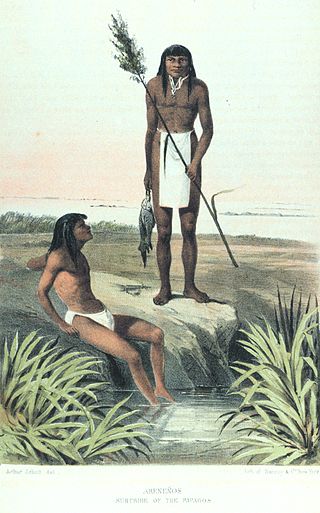
The Hia C-eḍ Oʼodham, also known as Areneños or Sand Papagos are a Native American peoples whose traditional homeland lies between the Ajo Range, the Gila River, the Colorado River, and the Gulf of California. They are currently unrecognized at both the state and federal level in the United States and Mexico, although the Tohono Oʼodham Nation has a committee for issues related to them and has land held in trust for them. They are represented by a community organization known as the Hia-Ced Oʼodham Alliance. The Hia C-eḍ Oʼodham are no longer nomadic, and the majority today live in or near Ajo, Arizona, or the small settlements of Blaisdell and Dome near Yuma.

Cycloloma is a monotypic genus which contains the sole species Cycloloma atriplicifolium, which is known by the common names winged pigweed, tumble ringwing, plains tumbleweed, and tumble-weed. This plant is native to central North America, but it is spreading and has been occasionally reported in far-flung areas from California to Maine to the Canadian prairie. It is considered an introduced species outside of central North America. This is a bushy annual herb forming a rounded pale green clump which may exceed 0.5 m in height. It is very intricately branched, with toothed leaves occurring near the base. The spreading stems bear widely spaced flowers are small immature fruits fringed with a nearly transparent membranous wing. In autumn, the plant forms a tumbleweed. The fruit is a utricle about 2 millimeters long containing a single seed.
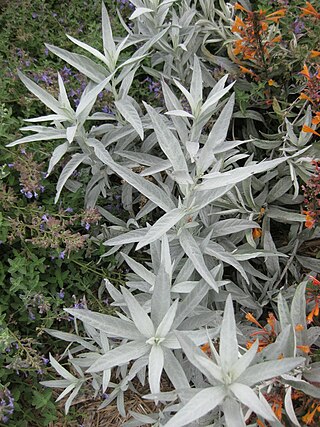
Artemisia ludoviciana is a North American species of flowering plant in the daisy family Asteraceae, known by several common names, including silver wormwood, western mugwort, Louisiana wormwood, white sagebrush, lobed cud-weed, prairie sage, and gray sagewort.
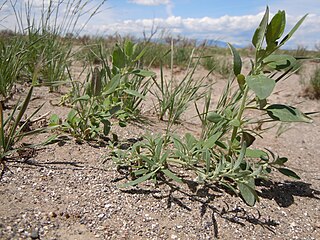
Chenopodium leptophyllum is a species of flowering plant in the family Amaranthaceae known by the common name narrowleaf goosefoot.
Abronia fragrans, the sweet sand-verbena, snowball sand-verbena, prairie snowball or fragrant verbena, is a species of sand verbena.

Yucca glauca is a species of perennial evergreen plant, adapted to xeric (dry) growth conditions. It is also known as small soapweed, soapweed yucca, Spanish bayonet, and Great Plains yucca.

Pectis papposa is a species of flowering plant in the family Asteraceae. It is native to North America, where it occurs in the southwestern United States as far east as Texas, and in northern Mexico. Common names include cinchweed, common chinchweed, many-bristle chinchweed, and many-bristle fetid-marigold.

Ruth Murray Underhill was an American anthropologist. She was born in Ossining-on-the-Hudson, New York, and attended Vassar College, graduating in 1905 with a degree in Language and Literature. In 1907, she graduated from the London School of Economics and began travelling throughout Europe. During World War I, she worked for an Italian orphanage run by the Red Cross.

The agricultural practices of the Native Americans inhabiting the American Southwest, which includes the states of Arizona and New Mexico plus portions of surrounding states and neighboring Mexico, are influenced by the low levels of precipitation in the region. Irrigation and several techniques of water harvesting and conservation were essential for successful agriculture. To take advantage of limited water, the southwestern Native Americans utilized irrigation canals, terraces (trincheras), rock mulches, and floodplain cultivation. Success in agriculture enabled some native Americans to live in communities which numbered in the thousands as compared to their former lives as hunter-gatherers in which their bands numbered only a few dozen.
This is a list of plants and how they are used in Zuni culture.
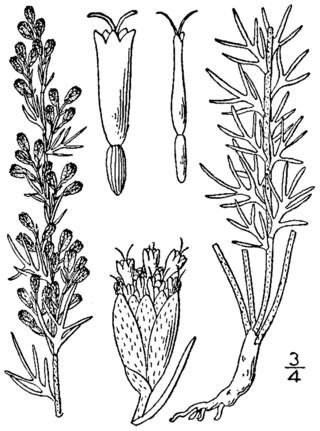
Artemisia carruthii, common name Carruth's sagewort or Carruth wormwood, is a North American species of shrubs in the daisy family native to much of south-central and southwestern United States. There are reports of a few naturalized populations in Missouri, the Great Lakes Region, and Rhode Island. It is also native to the States of Chihuahua and Sonora in northern Mexico.
Atriplex powellii, or Powell's saltweed, is a plant found in the United States and Canada.

Yepáchic, sometimes spelled Yepáchi, is a community in the western part of the Mexican State of Chihuahua, approximately 10 km (6.2 mi) east of the boundary with the State of Sonora. It is located in the Municipio de Temósachic at an altitude of 1,780 meters (5,840 ft) in the Sierra Madre Occidental. Many of the people of the region are members of the indigenous ethnic group called Mountain Pima or the Pima Bajo. They are related to the Pima and Papago of Arizona and northern Sonora, speaking a similar but distinct language.

Jaltomata procumbens, the creeping false holly, is a plant species native to Arizona, USA, Mexico, Central America, Colombia, Ecuador, and Venezuela. It grows as a weed in agricultural fields and other disturbed locations, but in many places the people protect it because of the edible fruits it produces.
Joseph Edward Laferrière is an American botanist with a particular interest in ethnobotany.
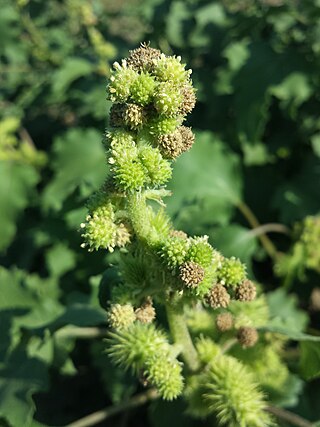
Xanthium orientale is a species of annual plant of the daisy family Asteraceae.

Dyssodia papposa is a species of annual herbaceous forb in the genus Dyssodia, commonly known as fetid marigold or prairie dogweed. It is native to North America and parts of the Southwest, extending into the Northeast. The plant has been used by Native Americans to treat multiple medical conditions.
References
- 1 2 3 "Inventory of the Edward Castetter papers on arid zone research". Rocky Mountain Online Archive. 2013. Retrieved 2016-10-15.
- ↑ "The Albert C. Hildebrandt Plant Pathology Library- Thesis by title". Penn State University. Department of Plant Pathology and Environmental Microbiology. Archived from the original on 3 January 2017. Retrieved 2016-10-15.
- ↑ Castetter, Edward F. (1924). Studies on the comparative cytology of the annual and biennial varieties of Melilotus alba (Thesis). Iowa State University.
- ↑ Sutton, Mark Q.; Sobolik, Kristin D.; Gardner, Jill K. (2010-04-15). Paleonutrition. University of Arizona Press. p. 9. ISBN 9780816508211. OCLC 754718548.
- ↑ Rea, Amadeo M. (1997-01-01). At the Desert's Green Edge: An Ethnobotany of the Gila River Pima. University of Arizona Press. ISBN 9780816515400. OCLC 951746363.
- ↑ , W.W.H (1938). "Bibliography of New Mexican Ethnology, and Ethnography, 1936 and 1937, with Resume of Southwestern Field Work". New Mexico Anthropologist. 2 (3): 52–62. doi:10.1086/newmexianthr.2.3.4291167. JSTOR 4291167.
- ↑ "AAAS Officers, Committees, and Representatives for 1956". Science. 123 (3190): 271–272. 1956-01-01. Bibcode:1956Sci...123..271.. doi:10.1126/science.123.3190.271. JSTOR 1750767.